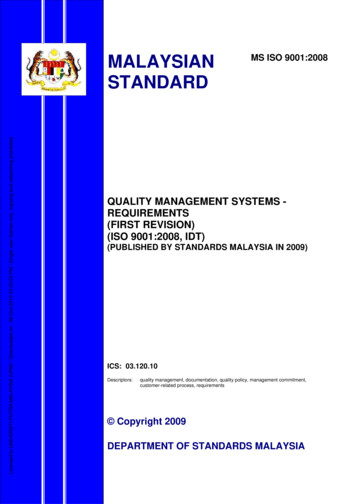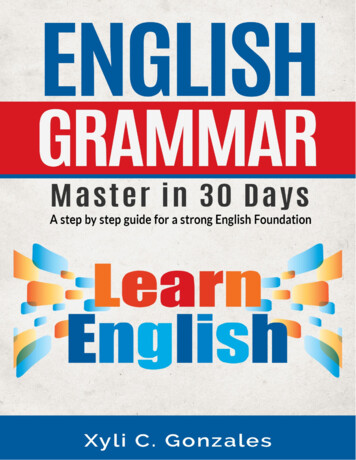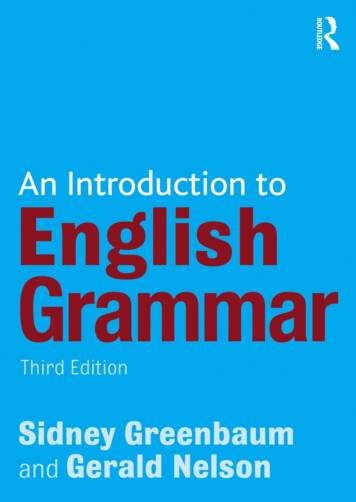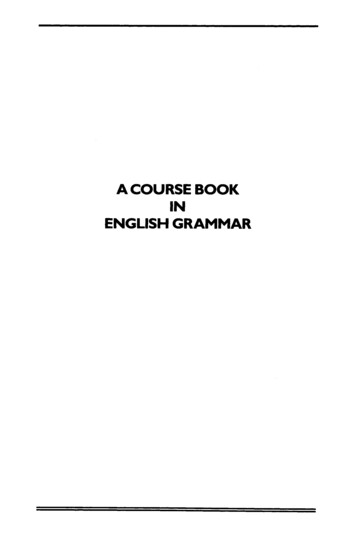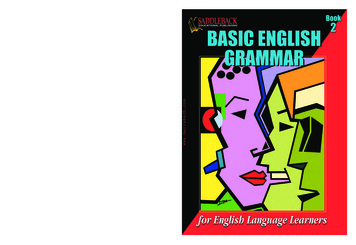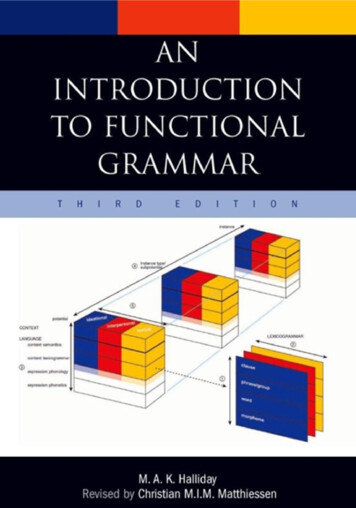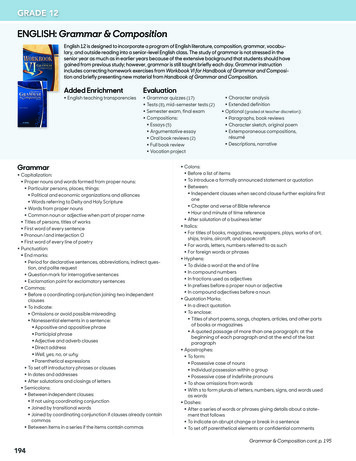
Transcription
Institut Pendidikan Guru Kampus Dato’ Razali IsmailTeaching EnglishGrammar inMalaysian PrimarySchoolsManual for short courseRuth Wickham, Brighton Education Training Fellow, IPGKDRI2011
English Grammar in Malaysian Primary SchoolsContentsIntroduction . 2Objectives . 2Materials . 2Procedures . 2Why do we teach Grammar? (Should we teach Grammar at all?) . 31. A quote from “English Club” . 32. Some thoughts from “Tips for English” . 43. Some words from “About.com” . 54. Notes about “Noticing” (excerpts from the article) . 65. Some excerpts from ELT Methodology: Principles and Practice . 7Your Notes: . 9Teaching English Grammar to Young Learners . 11Using Chants, Raps and Rhymes for Drilling . 12Vocabulary Chant . 12ACTIVITY: . 15Grammar Chant. 16ACTIVITY: . 18Jazz Chant . 18Drilling and Revision . 221. Typhoon . 222. Bingo . 243. Jeopardy . 25APPENDIX: . 28Notes from Wikipedia about Jeopardy. 281Ruth Wickham, Brighton Education Training Fellow, IPGKDRI
English Grammar in Malaysian Primary SchoolsIntroductionThis manual was written in 2011 in preparation for writing a full module about Teaching Grammar inMalaysian primary schools, to fit in with the new KSSR syllabus.ObjectivesParticipants will learn strategies for teaching Grammar to primary school students in interesting andengaging ways.MaterialsParticipants need to be able to discuss tasks in pairs and groups.Participants need writing materials and notebooks.ProceduresThis manual includes notes for facilitator and participants.(Future module will include separate notes, and PowerPoint presentation.)2Ruth Wickham, Brighton Education Training Fellow, IPGKDRI
English Grammar in Malaysian Primary SchoolsWhy do we teach Grammar? (Should we teach Grammar at all?)And what is the most effective way to teach grammar?Read and discuss with your group the following four brief articles from the Internet, and excerptfrom a book.1. A quote from “English Club”What is Grammar?Grammar is the system of a language. People sometimesdescribe grammar as the "rules" of a language; but in fact nolanguage has rules*. If we use the word "rules", we suggest thatsomebody created the rules first and then spoke the language,like a new game. But languages did not start like that. Languagesstarted by people making sounds which evolved into words,phrases and sentences. No commonly-spoken language is fixed.All languages change over time. What we call "grammar" issimply a reflection of a language at a particular time.Do we need to study grammar to learn a language? The shortanswer is "no". Very many people in the world speak their own,native language without having studied its grammar. Children start to speak before they even knowthe word "grammar". But if you are serious about learning a foreign language, the long answer is"yes, grammar can help you to learn a language more quickly and more efficiently." It's important tothink of grammar as something that can help you, like a friend. When you understand the grammar(or system) of a language, you can understand many things yourself, without having to ask a teacheror look in a book.So think of grammar as something good, something positive, something that you can use to findyour way - like a signpost or a map.* Except invented languages like Esperanto. And if Esperanto were widely spoken, its rules wouldsoon be very ar-what.htm3Ruth Wickham, Brighton Education Training Fellow, IPGKDRI
English Grammar in Malaysian Primary Schools2. Some thoughts from “Tips for English”Stephen Krashen, an expert linguist, specialized in theories of language acquisition and developmentand has researched the area of non-English and bilingual language acquisition.In what he originally called the input hypothesis, Krashen claims that humans acquire language onlythrough comprehensible input.“Language acquisition does not require extensive use of conscious grammatical rules, and does notrequire tedious drill.”“Acquisition requires meaningful interactions in the target language – natural communication – inwhich speakers are concerned not with the form of their utterances but with the messages they areconveying and understanding.”“The best methods are therefore those that supply ‘comprehensible input’ in low anxiety situations,containing messages that students really want to hear. These methods do not force early productionin the second language, but allow students to produce when they are ‘ready’, recognizing thatimprovement comes from supplying communicative and comprehensible input, and not from forcingand correcting production.”“In the real world, conversations with sympathetic native speakers who are willing to help theacquirer understand are very helpful.”The Role of Grammar in Krashen’s ViewThe only instance in which the teaching of grammar can result in language acquisition (andproficiency) is when the student and teacher are interested in the subject at hand and the targetlanguage is used for the explanation.Very often, both teachers and students are convinced that the study of formal grammar is essentialfor second language acquisition.When the skilful teacher can talk about grammar as the requirement for comprehensible input,coupled with the students’ genuine participation, the explanation is suitable for languageacquisition. When the affective filter is low and the learner’s conscious efforts are on the subjectmatter, the attention is on what is being talked about and not the medium.Teachers and learners should be careful not to deceive themselves. They can easily believe that it isthe study of grammar that is responsible for the learners’ progress. In reality, when grammar is usedas a meta-language for talking about grammar, progress comes from the medium and not themessage. Any subject matter that holds the learner’s interest would do just as well.http://www.tipsforenglish.com/?p 94Ruth Wickham, Brighton Education Training Fellow, IPGKDRI
English Grammar in Malaysian Primary Schools3. Some words from “About.com”Teaching Grammar in an ESL / EFL SettingOverview by Kenneth Beare, About.com GuideTeaching grammar plays a central role in every ESL / EFL teacher's classroom. Theimportant question that needs to be answered is: how do I teach grammar? In other words,how do I help students learn the grammar they need. This question is deceptively easy. Atfirst look, you might think that teaching grammar is just a matter of explaining grammar rulesto students. However, teaching grammar effectively is a much more complicated matter.Inductive and DeductiveInductive is known as a 'bottom up' approach. In other words, students discover grammarrules while working through exercises.For example:It could be a reading comprehension which includes a number of sentences which describewhat a person has done up to that period in time.After doing the reading comprehension, the teacher could begin to ask questions such as:‘How long has he done this or that?’ ‘Has he ever been to Paris?’ etc. and then follow with,‘When did he go to Paris?’To help the students inductively understand the difference between the simple past and thepresent perfect, these questions could be followed with, ‘Which questions spoke about adefinite time in the past?’ ‘Which questions asked about the person's general experience?’and so on.Deductive is known as a 'top down' approach. This is the standard teaching approach that hasa teacher explaining rules to the students.For example:The present perfect is made up of the auxiliary verb 'have' plus the past participle. It is used toexpress an action which has begun in the past and continues into the present moment. etc.http://esl.about.com/cs/teachingtechnique/a/a teachgrammar.htm5Ruth Wickham, Brighton Education Training Fellow, IPGKDRI
English Grammar in Malaysian Primary Schools4. Notes about “Noticing” (excerpts from the article)Teaching ESL Students to "Notice" Grammar (by Francis J. Noonan III)IntroductionMany teachers are confused on how to teach grammar. The form-focused instruction of the audiolingual method produced students that knew a lot about a language but could not apply what theyknew to spontaneous speech. Conversely, the lack of grammar instruction in the CommunicativeApproach has often produced students who communicate well but lack grammatical competency. Isit possible to teach grammar in a way that will help students develop grammatical competency, evenin spontaneous speech? This article explores a possible answer to this dilemma, the theory ofnoticing, and its application to the classroom.Why Noticing?The theoretical basis for noticing centres around the relationship between explicit and implicitknowledge. Explicit knowledge is conscious knowledge of grammar rules learned through formalclassroom instruction. For example, Li knows every rule about subject-verb agreement but makesfrequent mistakes in natural speech. This knowledge is only available to him when he has time tothink about the rules and then apply them (i.e. a grammar exercise or a writing assignment). Incontrast, implicit knowledge is unconscious, internalized knowledge of a language that is availablefor spontaneous speech. For example, Jim speaks English with near perfect use of the basic rules ofsubject-verb agreement. This is despite the fact that he may have no idea what subject-verbagreement is or what the rules are. (.)What is Noticing?Noticing is basically the idea that if learners pay attention to the form and meaning of certainlanguage structures in input, this will contribute to the internalization of the rule. (.)Remember, according to this theory, the primary nature of explicit knowledge is to developawareness of rather than production of target forms.How Do Teachers Help Students Notice?How can we as teachers help students notice target forms? (.)1. Explicit instruction -- instruction explaining and drawing attention to a particular form.2. Frequency -- the regular occurrence of a certain structure in input.3. Perceptual Salience -- highlighting or underlining to draw attention to a certain structure.4. Task Demands -- constructing a task that requires learners to notice a structure in order tocomplete it.(.)6Ruth Wickham, Brighton Education Training Fellow, IPGKDRI
English Grammar in Malaysian Primary Schools5. Some excerpts from ELT Methodology: Principles and Practiceby Nesamalar Chitravelu, Saratha Sithamparam, and Teh Soo Choon.What is grammar? (p196)It is possible that someone who can produce perfectly correct sentences and communicateefficiently may not be able to explain the rules of grammar. This is true of many speakers of English,including some native speakers. Such people have implicit knowledge of grammar – they knowgrammar at the level of use. One needs to have explicit knowledge of grammar to be able todescribe and explain the rules.The place of grammar in the communicative approach (p199)The communicative approach to language learning focuses on getting students to use language tocommunicate effectively. To achieve this, teachers usually put students into situations where theyare using the language not merely in response to the teacher’s instructions, but also because theyneed it to seek information, give information, solve a problem, etc. Is there a place for the teachingof grammar in such an approach?There are different views on this issue. At one end are teachers who prefer to teach accuracy first,that is, they begin by teaching grammar rules and basic sentences to equip students with a soundgrammatical base on which to develop communicative stills. At the other end are teachers whoassume that given sufficient input and opportunities to use English in purposeful communication(through communicative activities), students will eventually acquire implicit knowledge of grammar.Teachers who use the accuracy first model will probably produce students who can reproduceaccurately sentences learnt, but it is not certain how well these students can use these sentences inreal communication. Teachers who use the communication first model are likely to producestudents who are confident and fluent in communication. It is also true that there will begrammatical errors in their language use. Students who learn English through the communicationfirst model often develop the habit of using ungrammatical forms. And these inaccurate forms maybecome fossilised, that is, they become fixed and are extremely difficult to change. This should beavoided.Our aim in teaching English is to develop in our students both accuracy and fluency, so that weshould include both types of activities: activities focussing on grammar, and those focussing onfluency. There should be a balance of both types of activities to help students improve theircommunication skills.7Ruth Wickham, Brighton Education Training Fellow, IPGKDRI
English Grammar in Malaysian Primary SchoolsApproaches to grammar in communicative language learning:In covert grammar teaching, the teacher gets the pupils involved in using the structure withoutdrawing their attention to the grammatical rules. For example, to teach the structure, ‘Do you like.?’ the teacher gets students to interview their friends and write the names of five people who likeeach of the fruits listed in the worksheet. Students have to go round, asking their friends ‘Do you like.?’ in order to complete the task.The students’ attention is focussed on the activity and not the grammar rules, but they have ampleopportunity to practise the question form. It is important that the teacher maintains a warm andsupportive atmosphere so that students are not afraid to take risks to test their linguisticcompetence. Errors should be tolerated during the course of the activity. But they should also benoted down and dealt with at a later session.In overt grammar teaching, the teacher explicitly explains the rules when presenting the newlanguage. Traditionally, there are two options available to the teacher. One is to use a deductiveapproach. Typically, in this approach, the teacher presents the rules / patterns / generalisations andthen goes on to provide practise in the application of these rules.The other approach is the inductive approach or discovery method where the students are firstgiven a number of sample sentences containing the target forms and then the teacher guides thestudents into deriving the rule for themselves.Ideally, these two approaches should not be seen as separate, but rather as complementary. agrammar rule presented covertly via a text or communicative activity can be supported by an explicitexplanation to enable students to understand the rule. A grammar rule presented overtly orexplicitly should be supported by activities which encourage students to use the structures forcommunicative purposes. The main aim of teaching grammar is to help our students use Englishcorrectly in all forms of communication.8Ruth Wickham, Brighton Education Training Fellow, IPGKDRI
English Grammar in Malaysian Primary SchoolsYour Notes:Answer the following from your reading, your discussions, and your experience:Does learning “Grammar” help students to learn English?.In general terms, what is the best way to teach / learn Grammar?.Can Grammar be ‘fun’? / Should Grammar be ‘fun’? Why / why not?.Briefly explain these terms:‘accuracy first’ .‘communication first’ .‘covert grammar teaching’.‘overt grammar teaching’ .‘deductive approach’ .‘inductive / discovery approach’.9Ruth Wickham, Brighton Education Training Fellow, IPGKDRI
English Grammar in Malaysian Primary SchoolsDiscuss, and briefly describe how you could teach the simple present tense of the verb ‘to walk’ to ayear 3 class using:a deductive approach .an inductive / discovery approach .10Ruth Wickham, Brighton Education Training Fellow, IPGKDRI
English Grammar in Malaysian Primary SchoolsTeaching English Grammar to Young LearnersFour Basic Principles:1. FunChildren learn much better if they are havingfun.2. Involve as many senses as possibleLearning is retained better with moreconnections that are made through movement, sound, sight, smell, touch and even taste.Both physical activity and interaction with others also assist in memory retention.3. Start with what the students knowTeaching needs to move from the known to the unknown, learning must start from what thestudents already know.4. FunIt is really important for the students to be having fun.(In fact, older learners also learn better if they can ‘have fun’ and be engaged with the subjectmatter.)11Ruth Wickham, Brighton Education Training Fellow, IPGKDRI
English Grammar in Malaysian Primary SchoolsUsing Chants, Raps and Rhymes for DrillingWhy use chants, raps and rhymes? Fun – young students will be more motivated and enthusiasticIntonation – students will acquire natural intonation as they learn grammar patternsContext – the grammar concepts can better be taught in a contextMemory – material that is learnt as a song or rhythm is better remembered.There are essentially 3 different types of chant, all of which are useful for teaching grammar:Vocabulary ChantThe vocabulary chant teaches more than just vocabulary. Students learn vocabulary items in groupsor categories such as parts of speech, or countable and uncountable nouns.Creating a Vocabulary Chant1. Choose a theme, such as:1. Choose your themeFor music12Ruth Wickham, Brighton Education Training Fellow, IPGKDRI
English Grammar in Malaysian Primary Schools2. Choose 10-15 words in your theme:For roorhino / rhinoceroslion3. Count the syllables in e3kangaroorhino / rhinoceros2lionChoose a 2, 3, 1.zebracrocodilesnake13Ruth Wickham, Brighton Education Training Fellow, IPGKDRI
English Grammar in Malaysian Primary SchoolsAnd say your ake** When you say your chant, keep a strong 4-beat rhythm by putting one beat on each word and thenadding a *click at the end of the 1st 2nd and last lines.14Ruth Wickham, Brighton Education Training Fellow, IPGKDRI
English Grammar in Malaysian Primary SchoolsACTIVITY:Create a Vocabulary ChantBrainstorm a list of names for occupations, count the number of syllables in each:occupationsyllables occupationteacher2chef1syllablesSelect a 2-syllable word, a 3-syllable word, and a 1-syllable word.2-syllable: .3-syllable: .1-syllable: .Write your chant:.Mark where the *beats* are (4 on each line).Perform your chant.15Ruth Wickham, Brighton Education Training Fellow, IPGKDRI
English Grammar in Malaysian Primary SchoolsGrammar ChantThe grammar chant is designed to demonstrate a particular grammar feature with its variations. Assuch, it will be somewhat repetitive, and it will centre on a particular point of grammar. This is verysimilar to the ‘old-fashioned’ idea of chanting, for example, verb paradigmsfor example:I amwe areyou areyou arehe, she, it isthey are- with the addition of rhythm, some contextual information, and possibly interaction between two ormore parties.Creating a Grammar Chant1. Decide on the grammar feature to be practised.for example: comparatives and superlatives.2. Create a conversation, or series of statements, to demonstrate the point.for example:Jimmy is tall!Sally is taller!Tom is the tallest in the class!Jimmy can reach this high shelf.Sally can reach that higher shelf.Tom can reach the highest shelf, the top shelf.These statements can be elicited from the students, and adjusted or corrected as necessary.16Ruth Wickham, Brighton Education Training Fellow, IPGKDRI
English Grammar in Malaysian Primary Schools3. Note the stressed words or syllables, and create a rhythmic
think of grammar as something that can help you, like a friend. When you understand the grammar (or system) of a language, you can understand many things yourself, without having to ask a teacher or look in a book. So think of grammar as something good, something positive, something that you can use to find your way - like a signpost or a map.

